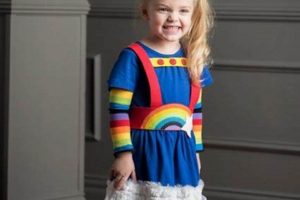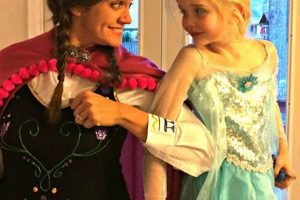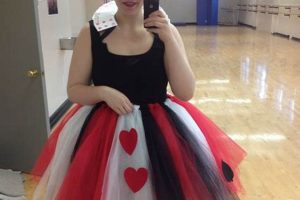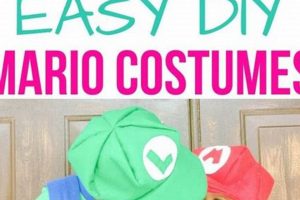A simple, homemade ensemble replicating the appearance of a sorceress, this project typically utilizes a dark-colored garment as its base. For example, an individual might repurpose an old black dress and supplement it with handcrafted accessories to achieve the desired aesthetic, circumventing the need for purchasing a pre-made outfit.
The appeal of creating such an outfit lies in its affordability and personalization. Individuals can express their creativity through unique accessory choices and garment alterations, resulting in a distinctive and potentially more impactful visual representation than commercially available alternatives. Furthermore, the practice aligns with principles of resourcefulness and sustainability by utilizing existing materials.
This approach offers a flexible and budget-conscious path to character representation. The following discussion will elaborate on techniques for accessorizing and customizing a dark dress to effectively convey a magical persona, focusing on readily available materials and simple crafting methods.
Tips for Crafting a Witch Costume from a Black Dress
Employing a dark garment as the foundation for a sorceress representation offers numerous avenues for creative expression. The subsequent advice aims to enhance the impact and authenticity of such an endeavor.
Tip 1: Fabric Selection is Paramount: Opt for fabrics with texture and drape. Velvet, lace, or even heavier cotton blends can add depth and visual interest to the costume, elevating it beyond a simple black dress. The texture should reflect the characters imagined background, whether rustic or regal.
Tip 2: Emphasize the Silhouette: Modify the dresss existing shape to enhance the desired witch-like aesthetic. Consider adding layers of tattered fabric, creating asymmetrical hemlines, or cinching the waist with a wide belt. The silhouette contributes significantly to the overall impression.
Tip 3: Accessory Integration is Key: A hat is almost essential. Construct one from cardboard and felt or repurpose an existing wide-brimmed hat. Jewelry can include pendants featuring arcane symbols or repurposed beads and stones, all in dark or muted colors. A staff, even a simple branch found outdoors, enhances the persona.
Tip 4: Makeup Articulation: Makeup choices should complement the costume’s style. Pale foundation, dark eyeshadow, and defined eyebrows can contribute to a classic witch look. Consider adding subtle details like painted wrinkles or a beauty mark for increased realism.
Tip 5: Consider Footwear: Boots, preferably dark and perhaps slightly worn, are ideal. Avoid brightly colored or overly modern footwear, as it detracts from the overall effect. If boots are unavailable, dark flats or even repurposed shoes can work with strategic accessorizing.
Tip 6: Detail with Belts and Corsets: Add a wide belt or mock corset over the black dress to define the waist and create a more structured silhouette. Leather, faux leather, or even thick fabric can be used, ideally with buckles or laces for added detail. Ensure the color complements the dress; dark brown or black is preferable.
Tip 7: Focus on Weathering and Texture: Applying light weathering techniques to the dress can enhance its worn and otherworldly appearance. This can involve lightly distressing the fabric with sandpaper, strategically applying diluted paint for a faded look, or adding small tears and rips for a more rugged aesthetic.
Successful execution of a sorceress representation from a dark garment involves meticulous attention to detail, strategic accessory choices, and a deliberate approach to silhouette and texture. These elements collectively contribute to a convincing and visually striking effect.
The subsequent section will address common pitfalls to avoid during the costume creation process, ensuring a polished and professional final result.
1. Simplicity
The concept of simplicity is central to the appeal and practicality of creating a dark dress sorceress representation. It streamlines the creation process, making it accessible to individuals with limited crafting experience and minimizing the resources required.
- Minimal Material Requirements
Simplicity dictates the utilization of readily available materials. A pre-owned or inexpensive dark dress serves as the primary component, reducing the need for extensive fabric sourcing or complex pattern construction. This principle minimizes both financial investment and time spent acquiring materials.
- Straightforward Construction Techniques
Projects emphasizing simplicity typically avoid intricate sewing or crafting methods. Instead, they favor techniques like cutting, gluing, and tying, allowing for rapid assembly and modification of the base garment. Elaborate pattern alterations or complicated construction steps are intentionally avoided.
- Reduced Time Commitment
The simplified approach significantly reduces the time investment required to complete the costume. Focus is placed on quick and effective alterations and accessory additions, enabling individuals to create a presentable and recognizable ensemble within a limited timeframe. This efficiency is particularly valuable for time-constrained individuals or last-minute costume needs.
- Adaptability and Customization
Simplicity does not preclude customization. The basic foundation allows for individualized embellishments and accessory choices, ensuring the costume reflects personal preferences and creative expression without requiring advanced crafting skills. Simple additions, such as a handmade hat or repurposed jewelry, can significantly enhance the overall aesthetic.
In essence, the adherence to simplicity in crafting a sorceress representation from a dark garment ensures accessibility, efficiency, and adaptability. This approach empowers individuals to create a recognizable and personalized costume without necessitating specialized skills or extensive resources. The resulting creation, while basic in construction, can be highly effective in conveying the desired character aesthetic.
2. Affordability
The economic feasibility of emulating a sorceress through self-made means constitutes a significant driving factor in its widespread adoption. Minimizing expenditure while achieving a recognizable and effective representation is a primary objective for many individuals.
- Repurposed Garments as a Foundation
The utilization of existing dark-colored garments, such as dresses or skirts, eliminates the need to purchase new fabric or pre-made costumes. Thrift stores and personal wardrobes offer ample opportunities to source suitable base materials at minimal cost. This practice aligns with principles of resourcefulness and re
duces reliance on commercial costume retailers. - Low-Cost Accessory Materials
Enhancements like hats, belts, and jewelry can be fashioned from inexpensive or recycled materials. Cardboard, felt, beads, and salvaged fabric scraps provide versatile options for creating convincing accessories without incurring significant expense. This approach fosters creativity and resourcefulness in material selection.
- DIY Makeup Alternatives
Professional-grade makeup is often unnecessary for achieving a suitable aesthetic. Everyday makeup products, combined with resourceful application techniques, can effectively simulate the desired features. Dark eyeshadow, eyeliner, and strategic contouring can create a dramatic effect without the need for specialized cosmetic purchases.
- Minimizing Tool and Equipment Investment
Complex sewing equipment and specialized crafting tools are generally not required. Basic sewing skills, coupled with readily available items like scissors, glue, and safety pins, are often sufficient for assembling and modifying the costume. This reduces the barrier to entry for individuals with limited access to crafting resources.
The convergence of repurposed materials, low-cost accessories, DIY makeup alternatives, and minimal tool investment collectively contribute to the affordability of creating a sorceress representation from a dark garment. This economic accessibility broadens the appeal of costume creation, enabling a wider range of individuals to participate in the practice without incurring substantial financial burden.
3. Creativity
Creativity forms the cornerstone of the dark dress sorceress representation endeavor. Without creative input, the project remains a simple exercise in garment selection. The transformation of a basic dark dress into a recognizable and compelling sorceress portrayal hinges on the individual’s ability to conceptualize, design, and execute modifications and additions that imbue the garment with character and narrative. A lack of imagination results in a generic and uninspired outcome, failing to capture the essence of the intended character. For example, the strategic placement of tattered lace, the construction of a unique hat adorned with handcrafted embellishments, or the imaginative use of makeup to create a distinctive facial expression are all direct results of creative thinking.
The application of creative thought extends beyond mere aesthetics. It encompasses problem-solving and resourcefulness. Individuals may encounter limitations in available materials or skills, requiring them to devise innovative solutions. For instance, if genuine leather is unavailable for a belt, a resourceful individual might repurpose a sturdy fabric and employ paint or stitching techniques to simulate the appearance of leather. Ornaments, such as pendants or brooches, may be created using clay, beads, or found objects, demonstrating an ability to adapt to constraints and generate original designs. Creativity facilitates the construction of a costume that reflects a unique vision, transcending the limitations of commercial alternatives.
In summary, the success of a self-made sorceress outfit relies heavily on the infusion of imagination and ingenuity. It enables the transformation of a basic garment into a personalized and visually engaging representation. The act of creative expression elevates the project beyond mere costume construction, transforming it into an artistic endeavor with inherent value. The willingness to experiment, innovate, and adapt is crucial for achieving a distinctive and memorable outcome.
4. Versatility
The inherent adaptability of a dark dress significantly contributes to the feasibility and appeal of a self-made sorceress outfit. A basic dark garment serves as a neutral foundation, readily modified to reflect diverse interpretations of the character archetype. This adaptability proves crucial for individuals seeking a personalized expression without the constraints of pre-defined costume designs. Examples of this versatility manifest in the ability to represent benevolent or malevolent sorceresses through subtle adjustments to accessories and makeup, or to adapt the costume for various historical or fantastical settings. The underlying dark garment functions as a blank canvas, enabling an individual to realize a unique and specific vision.
This versatility extends to practical considerations. The same dark dress, with minor alterations, can be repurposed for various costume themes beyond that of a sorceress. A simple change in accessories can transform the outfit into a vampire, a gothic character, or even a mourning attire, allowing for multiple uses of a single garment. This reduces wardrobe clutter and promotes sustainable costume practices. The adaptability of the dark dress also accommodates different body types and sizes, offering a more inclusive and accessible costume option compared to pre-sized commercial costumes. Adjustments such as adding panels, altering the hemline, or incorporating elastic elements allow for a comfortable and flattering fit regardless of individual body shape.
In essence, the versatility inherent in using a dark dress as the basis for a sorceress outfit provides significant advantages in terms of customization, reusability, and inclusivity. While the initial garment may appear simple, its capacity for transformation empowers individuals to create personalized, practical, and adaptable costume solutions. The challenge lies in harnessing this potential through creative accessory selection and thoughtful design modifications, ensuring the final product accurately reflects the desired character while maximizing the garment’s inherent flexibility.
5. Individuality
The deliberate creation of a sorceress representation based on a dark dress inherently promotes self-expression. Mass-produced costumes often enforce conformity, whereas a self-made ensemble encourages individuals to imprint their unique aesthetic and personal interpretation onto the character.
- Personalized Narrative Integration
A constructed outfit allows for the incorporation of elements reflecting a specific backstory or characteristic traits conceived by the individual. For example, incorporating specific symbols or tokens relating to a fictional heritage or skill set can elevate the garment beyond a mere costume and imbue it with personal significance. This contrasts with the generic representations found in commercially available options.
- Unique Accessory Selection
The freedom to curate accessories independently fosters distinctiveness. Rather than relying on standardized costume sets, individuals can source items from various sources, including thrift stores, craft supplies, and personal collections, resulting in a non-uniform appearance. This approach yields a more authentic and compelling visual representation, reflecting the individual’s stylistic preferences.
- Tailored Fit and Silhouette
Unlike pre-sized costumes, a self-made outfit allows for adjustments that accommodate individual body types and preferences. This ensures a more flattering and comforta
ble fit, enhancing the wearer’s confidence and overall appearance. The ability to modify the silhouette through alterations and layering further contributes to the individual’s control over the final aesthetic. - Material and Texture Choices
The selection of fabrics, textures, and embellishments provides a powerful means of expressing individuality. Experimentation with unconventional materials and techniques can result in a distinctive and memorable costume that deviates from traditional representations. This can include incorporating unusual patterns, textures, or repurposed materials to create a truly unique visual statement.
The convergence of personalized narrative integration, unique accessory selection, tailored fit, and conscious material choices results in a costume that transcends mere imitation. The constructed sorceress outfit becomes an extension of the individual’s identity, reflecting their creative vision and personal style. The resulting visual representation serves as a testament to the power of self-expression and the inherent limitations of standardized costume options.
6. Accessibility
The ease with which individuals can create a sorceress representation from a dark dress constitutes a core element of its appeal. This accessibility stems from several factors, each contributing to the demystification and simplification of costume creation. A primary driver is the ready availability of the base garment; dark dresses are commonly found in personal wardrobes, thrift stores, or discount retailers. This eliminates the need for specialized or expensive fabric purchases. Furthermore, the skills required for basic alterations, such as hemming, adding simple embellishments, or attaching accessories, are generally within the grasp of individuals with minimal crafting experience. The absence of complex pattern making or advanced sewing techniques lowers the barrier to entry significantly.
Beyond the garment itself, the accessibility factor extends to accessory creation and makeup application. Many suitable accessories can be fashioned from readily available materials, such as cardboard, felt, or repurposed jewelry. Online tutorials and readily accessible crafting guides offer step-by-step instructions, empowering individuals to create convincing accouterments without requiring specialized training or expensive equipment. Similarly, achieving a sorceress-inspired makeup look often relies on techniques that can be mastered through online resources, utilizing commonly available cosmetic products. A real-world example includes community costume workshops, where participants collaboratively create sorceress outfits from repurposed materials and share accessible crafting techniques, further enhancing accessibility for individuals regardless of their financial or skill-based limitations.
In conclusion, the widespread adoption of the dark dress sorceress representation is directly attributable to its inherent accessibility. This attribute empowers individuals, regardless of their financial resources, crafting expertise, or access to specialized tools, to participate in creative expression and costume creation. The challenge lies in promoting and maintaining this accessibility through continued sharing of accessible crafting techniques and resourcefulness, ensuring the creation of these ensembles remains an inclusive and democratized activity.
Frequently Asked Questions About Creating a Sorceress Representation Using a Dark Dress
The subsequent questions and answers address common inquiries regarding the construction and implementation of a sorceress-themed costume based on a pre-existing dark-colored dress. The information presented aims to clarify best practices and mitigate potential challenges.
Question 1: What constitutes a suitable dark dress for this type of project?
A suitable dress possesses a color saturation ranging from deep gray to black. Fabric type is a secondary consideration, although heavier materials often lend themselves to a more robust and visually compelling silhouette. Avoid dresses with overly bright or modern patterns, as these can detract from the desired aesthetic.
Question 2: Are specialized crafting skills required to effectively create this costume?
Specialized skills are not a prerequisite. Basic sewing or gluing skills are beneficial but can be compensated for through resourceful adaptation and strategic use of accessories. Focus on techniques such as cutting, layering, and attaching pre-made components to the base garment.
Question 3: How can a convincing sorceress hat be created at minimal cost?
A cost-effective hat can be fashioned from cardboard or heavy felt. The cardboard method involves creating a cone shape and attaching a wide brim. Felt can be molded and stiffened with fabric stiffener. Embellishments can include feathers, beads, or scraps of fabric, all secured with glue or basic stitching.
Question 4: What makeup techniques are most effective for portraying a sorceress?
Effective makeup techniques involve emphasizing the eyes and cheekbones. Dark eyeshadow, eyeliner, and mascara contribute to a dramatic effect. Pale foundation and strategic contouring can further enhance the character’s features. Consider adding subtle details such as dark lip color or painted beauty marks.
Question 5: How can the costume be adapted for varying weather conditions?
Adaptations for weather can include layering garments underneath the dress for warmth or utilizing lightweight fabrics for warmer climates. Consider incorporating a cloak or shawl for added coverage in colder conditions. Footwear should be selected based on the weather, opting for boots in wet or cold environments.
Question 6: What are some common mistakes to avoid during the costume creation process?
Common mistakes include neglecting attention to detail, utilizing ill-fitting garments, and employing accessories that clash with the overall aesthetic. Avoid excessive embellishment or the use of overly modern or brightly colored components, as these can detract from the desired effect.
Successful creation of a dark dress sorceress outfit involves careful consideration of garment selection, accessory integration, makeup application, and adherence to fundamental crafting principles. Attention to detail and a commitment to a cohesive aesthetic contribute significantly to the final result.
The subsequent section will delve into advanced techniques for embellishing and customizing the costume, offering additional strategies for achieving a visually striking and personalized representation.
Conclusion
The preceding discussion has explored the multifaceted aspects of creating a sorceress representation using a dark dress as its foundation. Key elements examined encompass simplicity, affordability, creativity, versatility, individuality, and accessibility, each demonstrating a significant contribution to the endeavor’s feasibility and widespread appeal. Effective execution hinges on thoughtful garment selection, strategic accessory integration, and adherence to fundamental crafting principles.
The synthesis of these components empowers individuals, regardless of skill level or financial resources, to engage in personalized costume design. Continued exploration of innovative techniques and resource utilization remains crucial for fostering inclusivity and promoting the enduring accessibility of this form of creative self-expression. Further investigation into the historical
and cultural significance of sorceress costuming, and how these aspects can be translated into a DIY project, may also prove fruitful.







